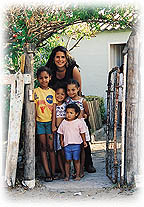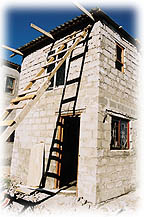First Person - January 26, 2000
Building homes in the land of apartheid
An architecture major learns the value of collaboration
By Maria Burnett-Gaudiani '98
 Completely ignorant of the intense topographical elegance of South Africa,
I enrolled in the University of Cape Town for my junior spring semester.
Florence is the suggested study abroad destination for architecture majors,
but I sought a greater adventure. I congratulated myself as the plane turned
and Table Mountain came into stunning view; the Atlantic and Indian Oceans
stretched endlessly into the sunrise. It was February 1997.
Completely ignorant of the intense topographical elegance of South Africa,
I enrolled in the University of Cape Town for my junior spring semester.
Florence is the suggested study abroad destination for architecture majors,
but I sought a greater adventure. I congratulated myself as the plane turned
and Table Mountain came into stunning view; the Atlantic and Indian Oceans
stretched endlessly into the sunrise. It was February 1997.
Six months later I had written a junior paper on the contentious issue
of low-cost housing design under the new African National Congress government,
taken classes on various aspects of the culture, and become forever bonded
to the other Princetonians who witnessed Cape Town that spring.
The junior paper had been a struggle. Starting in the library proved
fruitless. The history of black housing in the Cape and its impact on the
present situation remained to be written; the National Party had censored
what documentation did exist. Though I had passed the vast landscapes of
squatter camps on the highway, I had no way of accessing those people and
their histories.
My plan of attack changed course repeatedly. All were fruitless until,
by happenstance, I met a woman who knew an architect with similar interests.
I remained skeptical (people had tried to help, but often urged me to write
about Cape Dutch architecture). Convinced that an important topic brewed
within those shacks, I met that architect, and research sprang to life.
He led me day after day into the winding narrow streets of Crossroads, Guguletu,
and Philippi. Eventually, communities opened up to me, and I learned how
this tragic landscape had developed and how they lived each day. The architect
was in the process of negotiating with a squatter women's group and a landowner
to erect a large housing development on an empty tract of land. It was close
to main roads and not too far from the central business district. Surrounded
by shacks, armed chicken vendors, and a sheep abattoir, the land was considered
a diamond in the rough.
 As I finished my paper and made plans to travel to Zambia for the summer,
the architect's vision of development was becoming a reality. Saying goodbye
to the community, I swore to come back after I finished my degree.
As I finished my paper and made plans to travel to Zambia for the summer,
the architect's vision of development was becoming a reality. Saying goodbye
to the community, I swore to come back after I finished my degree.
The Henry Labouisse '22 Fellowship, which funds recent graduates to work
in disadvantaged communities, brought my promise to fruition. Within a year
of departing, I was back, car shopping, moving into a flat, and amongst
a community beginning construction.
They poured the first foundation and began the laborious process of constructing
250 houses on a bare site.
Beyond the challenges of the construction itself, we wanted a collaboration
(to find an architectural form that accommodated the community needs and
a process that could be widely replicated). Because the women had long idealized
one-story houses, the architect's vision of two-story homes with 33-square-meter
foundations proved a difficult battle. The most financially economical house
was certainly the latter. But age-old perceptions of rural versus urban
settlements and black versus white housing prevented design based on pure
economics. Compromises were made; many older women chose the one-story while
the younger opted for our design. Even after we settled those issues, untrained
workers rarely built precisely from the approved plans. That led to hours
of Sisyphus-like work redrawing to satisfy the town council's requirements.
I had enrolled in Xhosa classes, the language of the community, because
I wanted to communicate with the women and workers on their terms; it seems
they spent decades doing the opposite. While teaching soon-to-be homeowners
how to read plans and elevations and helping to actually build the houses,
I learned that this is where the resolution of apartheid's legacy will transpire.
Centuries of British and Dutch colonization and the abuses of those regimes
caused miscommunication between the races on our site every day. Although
I left to pursue graduate school in London, I know I will return.
Maria Burnett-Gaudiani is finishing a master's in the history and theory
of architecture at the Architectural Association in London.
GO TO
the Table of Contents of the current issue
GO TO
PAW's home page
PAW@princeton.edu
 Completely ignorant of the intense topographical elegance of South Africa,
I enrolled in the University of Cape Town for my junior spring semester.
Florence is the suggested study abroad destination for architecture majors,
but I sought a greater adventure. I congratulated myself as the plane turned
and Table Mountain came into stunning view; the Atlantic and Indian Oceans
stretched endlessly into the sunrise. It was February 1997.
Completely ignorant of the intense topographical elegance of South Africa,
I enrolled in the University of Cape Town for my junior spring semester.
Florence is the suggested study abroad destination for architecture majors,
but I sought a greater adventure. I congratulated myself as the plane turned
and Table Mountain came into stunning view; the Atlantic and Indian Oceans
stretched endlessly into the sunrise. It was February 1997. As I finished my paper and made plans to travel to Zambia for the summer,
the architect's vision of development was becoming a reality. Saying goodbye
to the community, I swore to come back after I finished my degree.
As I finished my paper and made plans to travel to Zambia for the summer,
the architect's vision of development was becoming a reality. Saying goodbye
to the community, I swore to come back after I finished my degree.